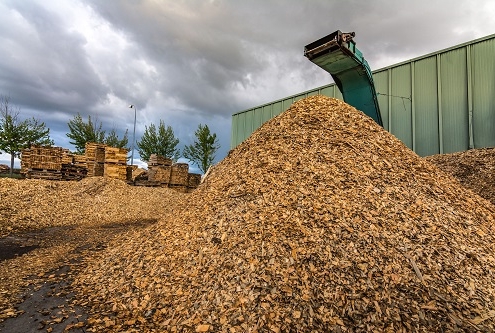Wood Packaging is the Most Recycled Packaging Material
Wood is recyclable. The recycling of wood pallets and wood packaging material is being done at a very high level throughout North America.
Recycling takes place throughout the product use cycle. New pallet manufacturing is only one part of how pallets are used. The pallet usage cycle also involves the recovery and reuse of pallets that are in good condition as well as the repair and reconstruction of damaged pallets. Pallets can also be dismantled and the lumber used to remanufacture new pallets.
With the application of grinding, wood pallets and components that are at the end of their useful life cycle end up in fiber-based products such as landscape mulch, animal bedding, soil enhancements, wood particle board, or are used in bioenergy and biomass applications.
This model enables the reuse of wood packaging materials and pallets that make multiple trips before they reach the end of their useful life, therefore minimizing waste generation and reducing overall consumption of wood fiber.
United States
According to new research conducted by Virginia Tech and the USDA Forest Service, in 2016, 508 million new pallets were manufactured. In the same year, 341 million pallets were recovered out of which only 25.39 million wooden pallets were landfilled in 2016, resulting in a recycling rate of 95%. Only 1.8% of all wood landfilled by an MSW (municipal and solid waste) and 5.6% landfilled by a C&D (construction and demolition) landfill were wood pallets.1 The extremely high rate of recycling could be attributed to the increased environmental awareness of companies and the emerging zero-landfill policies that prevent companies from sending packaging materials to landfills.
Use of recovered wood in pallet manufacturing is growing at a high rate.
To claim that a product is recyclable there should be recycling facilities available to at least 60% of the consumers where the product is sold.2 In the United States there is a comprehensive network of pallet recyclers serving the industrial and retail marketplace that far exceeds the 60% requirement.3
Canada
In Canada, there are in excess of 100 companies engaged in the recycling of wood packaging as a primary function of their business, and many more who are involved to a lesser extent. This network of companies is extremely effective in collecting, reusing, repurposing, and diverting from landfills millions of articles of wood packaging annually. So effective that a 2014 government publication stated that “Wood packaging is regarded as an insignificant waste issue due to the success of the reuse and recycling programs in place.”4
Wood is Nature’s Packaging.
Related Papers
- Pallet Market and Pallet Recovery Survey. “Investigation of New & Recovered Shipping Platforms in the USA.” Peer-reviewed article (Bioresources Journal, March 2020).
- VA Tech Research Shows a Whopping 95% of Wooden Pallets are Recycled (2018)
- The Current State of Wood Reuse and Recycling in North America and Recommendations for Improvements (Dovetail Partners, May 2013)
- Pallet Re-Use and Recycling Saves High Value Material from Landfills (College of Natural Resources, Engagement Matters)
- Value-Added Wood Products Marketing Guide for Manufacturers and Entrepreneurs (USDA January 2010)
- Wood and Carbon Footprint (Woodworks 2011)
- Wood Pallets and Landfills – Status and Opportunities for Economic Recovery and Recycling (USDA Forest Service & Virginia Tech, 1998)
Sources
- The Extraordinary Life Cycle of Pallets (March 2018 PalletCentral) by Laszlo Horvath, PhD, Virginia Tech; Brad Gething, PhD, NWPCA; Phil Araman, USDA Forest Service
- US Federal Trade Commission Environmental Claims: Summary of the Green Guides
- Search the NWPCA Directory and WPA Recyclers Directory
- Search the CWPCA Recyclers Directory

